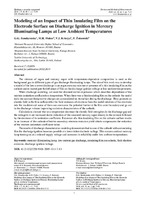| dc.contributor.author | Bondarenko, G. G. | en |
| dc.contributor.author | Fisher, M. R. | en |
| dc.contributor.author | Kristya, V. I. | en |
| dc.contributor.author | Żukowsk, P. | en |
| dc.coverage.spatial | Минск | ru |
| dc.date.accessioned | 2019-10-01T11:29:46Z | |
| dc.date.available | 2019-10-01T11:29:46Z | |
| dc.date.issued | 2019 | |
| dc.identifier.citation | Modeling of an Impact of Thin Insulating Film on the Electrode Surface on Discharge Ignition in Mercury Illuminating Lamps at Low Ambient Temperatures = Моделирование влияния тонкой диэлектрической пленки на поверхности электрода на зажигание разряда в ртутных осветительных лампах при низких температурах окружающей среды / G.G Bondarenko [et al.] // Приборы и методы измерений. - 2019. - Т. 10, № 1. - С. 7-13. | en |
| dc.identifier.uri | https://rep.bntu.by/handle/data/57471 | |
| dc.description.abstract | The mixture of argon and mercury vapor with temperature-dependent composition is used as the background gas in different types of gas discharge illuminating lamps. The aim of this work was to develop a model of the low-current discharge in an argon-mercury mixture at presence of a thin insulating film on the cathode and to investigate the influence of film on the discharge ignition voltage at low ambient temperatures. When discharge modeling, we used the obtained earlier expression which describes dependence of the mixture ionization coefficient on temperature. When there was a thin insulating film on the cathode the model took into account that positive charges are accumulated on its surface during the discharge. They generate an electric field in the film sufficient for the field emission of electrons from the metal substrate of the electrode into the insulator and some of them can overcome the potential barrier at the film outer boundary and go out in the discharge volume improving emission characteristics of the cathode. Calculations showed that at a temperature decrease the electric field strengthes in the discharge gap and the voltage in it are increased due to reduction of the saturated mercury vapor density in the mixture followed by the decrease of its ionization coefficient. Existence of a thin insulating film on the cathode surface results in an increase of the cathode effective secondary electron emission yield which compensates the reduction of the mixture ionization coefficient value. The results of discharge characteristics modeling demonstrate that in case of the cathode with an insulating film the discharge ignition becomes possible at a lower inter-electrode voltage. This ensures outdoor mercury lamp turning on at a reduced supply voltage and increases its reliability under low ambient temperatures. | en |
| dc.language.iso | en | en |
| dc.publisher | БНТУ | ru |
| dc.title | Modeling of an Impact of Thin Insulating Film on the Electrode Surface on Discharge Ignition in Mercury Illuminating Lamps at Low Ambient Temperatures | en |
| dc.title.alternative | Моделирование влияния тонкой диэлектрической пленки на поверхности электрода на зажигание разряда в ртутных осветительных лампах при низких температурах окружающей среды | ru |
| dc.type | Article | ru |
| local.description.annotation | Смесь аргона и паров ртути с зависящим от температуры составом используется в качестве рабочего газа в различных типах газоразрядных осветительных ламп. Целью данной работы являлось построение модели слаботочного разряда в смеси аргон-ртуть при наличии на катоде тонкой диэлектрической пленки, а также определение ее влияния на напряжение зажигания разряда при низкой температуре окружающей среды. При моделировании разряда мы использовали полученное ранее выражение, описывающее зависимость ионизационного коэффициента рассматриваемой смеси от температуры. В случае наличия на катоде тонкой диэлектрической пленки в модели учитывали, что в разряде на ее поверхности накапливаются положительные заряды. Они создают в пленке электрическое поле, достаточное для возникновения полевой эмиссии электронов из металлической подложки электрода в диэлектрик, часть из которых может преодолевать потенциальный барьер на внешней границе пленки и выходить в разрядный объем, улучшая эмиссионные характеристики катода.
Расчеты показали, что при снижении температуры происходит увеличение напряженности электрического поля в разрядном промежутке и напряжения на нем, обусловленное уменьшением концентрации насыщенных паров ртути в смеси, а следовательно, и ее ионизационного коэффициента. Наличие же тонкой диэлектрической пленки на поверхности катода может приводить, вследствие существования полевой эмиссии электронов в пленку, к увеличению эффективного коэффициента электронной эмиссии катода, компенсирующему снижение величины ионизационного коэффициента. Представленные результаты моделирования характеристик разряда демонстрируют, что в случае катода с диэлектрической пленкой становится возможным возникновение разряда при более низком межэлектродном напряжении. Это обеспечивает зажигание лампы наружного освещения при меньшем напряжении питающей сети и повышает ее надежность в условиях низких температур. | ru |

